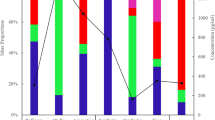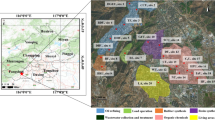Abstract
Emission characteristics of volatile organic compounds (VOC) emitted from the tank farm of petroleum refinery were evaluated in this study in order to analyze for the potential impacts on health and odor nuisance problems. Estimation procedures were carried out by using the U.S.EPA TANK 4.0.9d emission model in conjunction with direct measurements of gas phase of each stored liquid within aboveground storage tanks. Results revealed that about 61.12% of total VOC emitted from the tank farm by volume were alkanes, in which pentane were richest (27.4%), followed by cyclopentane (19.22%), propene (19.02%), and isobutene (14.22%). Mostly of pentane (about 80%) were emitted from the floating roof tanks contained crude oil corresponded to the largest annual throughput of crude oil as compared with other petroleum distillates. Emission data were further analyzed for their ambient concentration using the AERMOD dispersion model in order to determine the extent and magnitude of odor and health impacts caused by pentane. Results indicated that there was no health impact from inhalation of pentane. However, predicted data were higher than the odor threshold values of pentane which indicated the possibility of odor nuisance problem in the vicinity areas of the refinery. In order to solve this problem, modification of the type of crude oil storage tanks from external floating roof to domed external floating roof could be significant success in reduction of both emissions and ambient concentrations of VOC from petroleum refinery tank farm.





Similar content being viewed by others
References
Abdelrasoul A, Khan AR, Al-Hadad A. Oil refineries emissions impact on urban localities using AERMOD. Am J Environ Sci. 2010;6(6):505–15.
Beckman JR. Breathing losses from fixed-roof tanks by heat and mass transfer diffusion. Ind Eng Chem Process Des Dev. 1984;23(3):472–9.
Beckman JR, Gllmer JR. Model for predicting emissions from fixed-roof storage tanks. Ind Eng Chem Process Des Dev. 1981;20(4):646–51.
Carletti S, Giovanni DN. Evaluation of fugitive emissions of hydrocarbons from a refinery during a significant pollution episode. In: 9th International Conference on Environmental Engineering; 2014.
Cerón-Bretón JG, Cerón-Bretón RM, Kahl JDW, Ramírez-Lara E, Aguilar-Ucán CA, Montalvo-Romero C, et al. Carbonyls in the urban atmosphere of Monterrey, Mexico: sources, exposure, and health risk. Air Qual Atmos Health. 2016;10(1):53–67.
Chang JI, Lin C-C. A study of storage tank accidents. J Loss Prev Process Ind. 2006;19(1):51–9.
Chen H, Carter KE. Modeling potential occupational inhalation exposures and associated risks of toxic organics from chemical storage tanks used in hydraulic fracturing using AERMOD. Environ Pollut. 2017;224:300–9.
Dai H, Jing S, Wang H, Ma Y, Li L, Song W, et al. VOCS characteristics and inhalation health risks in newly renovated residences in Shanghai, China. Sci Total Environ. 2017;577:73–83.
Henmi T, Flanigan R, Padilla R. Development and application of an evaluation method for the WRF mesoscale model. Army research laboratory. 2005:ARL–TR3657.
Howari FM. Evaporation losses and dispersion of volatile organic compounds from tank farms. Environ Monit Assess. 2015;187(5):273.
Jayadipraja E, Daud A, Assegaf A, Maming M. The application of the AERMOD model in the environmental health to identify the dispersion area of total suspended particulate from cement industry stacks. J Res Med Sci. 2016:2044–9.
Jittra N, Pinthong N, Thepanondh S. Performance evaluation of AERMOD and CALPUFF air dispersion models in industrial complex area. Air Soil Water Res. 2016;8:87–95.
Jovanovic J, Jovanovic M, Jovanovic A, Marinovic V. Introduction of cleaner production in the tank farm of the Pancevo oil refinery, Serbia. J Clean Prod. 2010;18(8):791–8. https://doi.org/10.1016/j.jclepro.2010.01.002.
Kampeerawipakorn O, Navasumrit P, Settachan D, Promvijit J, Hunsonti P, Parnlob V, et al. Health risk evaluation in a population exposed to chemical releases from a petrochemical complex in Thailand. Environ Res. 2017;152:207–13.
Khamyingkert L, Thepanondh S. Analysis of industrial source contribution to ambient air concentration using AERMOD dispersion model. EnvironmentAsia. 2016;9(1):28–36.
Kumar A, Patil R, Dikshit A, Kumar R. Application of WRF model for air quality modelling and AERMOD – a survey. Aerosol Air Qual Res. 2017;17:1925–37.
Lin T-Y, Sree U, Tseng S-H, Chiu KH, Wu C-H, Lo J-G. Volatile organic compound concentrations in ambient air of Kaohsiung petroleum refinery in Taiwan. Atmos Environ. 2004;38(25):4111–22.
Lu C, Huang H, Chang S, Hsu S. Emission characteristics of VOC from three fixed-roof p-xylene liquid storage tanks. Environ Monit Assess. 2013;185(8):6819–30.
Malakan W, Keawboonchu J, Thepanondh S. Comparison of AERMOD performance using observed and prognostic meteorological data. EnvironmentAsia. 2018;11(2):38–52.
Mokhtar MM, Hassim MH, Taib RM. Health risk assessment of emissions from a coal-fired power plant using AERMOD modelling. Process Saf Environ Prot. 2014;92(5):476–85.
Niu Z, Zhang H, Xu Y, Liao X, Xu L, Chen J. Pollution characteristics of volatile organic compounds in the atmosphere of Haicang District in Xiamen City, Southeast China. J Environ Monit. 2012;14(4):1145–52.
Rota R, Frattini S, Astori S, Paludetto R. Emissions fromfixed-roof storage tanks: modeling and experiments. Ind EngChem Res. 2001;40:5847–57.
Rovira E, Cuadras A, Aguilar X, Esteban L, Borras-Santos A, Zock JP, et al. Asthma, respiratory symptoms and lung function in children living near a petrochemical site. Environ Res. 2014;133:156–63.
Sirithian, D., Thepanondh, S., Laowagul, W., & Morknoy. (2017). Atmospheric dispersion of polycyclic aromatic hydrocarbons from open burning of agricultural residues in Chiang Rai, Thailand. Air Qual Atmos Health 10, 861–871.
Sirithian D, Thepanondh S, Sattler ML, Laowagul W. Emissions of volatile organic compounds from maize residue open burning in the northern region of Thailand. Atmos Environ. 2018;176:179–87.
Thawonkaew A, Thepanondh S, Sirithian D, Jinawa L. Assimilative capacity of air pollutants in an area of the largest petrochemical complex in Thailand. Int J of GEOMATE. 2016;11(23):2162–9.
Thepanondh, S., Outapa, P., Saikomol, S. (2016). Evaluation of dispersion model performance in predicting SO2 concentrations from petroleum refinery complex. Int J of GEOMATE, 11(23), 2129–2135.
Truong SCH, Lee M-I, Kim G, Kim D, Park J-H, Choi S-D, et al. Accidental benzene release risk assessment in an urban area using an atmospheric dispersion model. Atmos Environ. 2016;144:146–59.
Tunlathorntham S, Thepanondh S. Prediction of ambient nitrogen dioxide concentrations in the vicinity of industrial complex area, Thailand. Air Soil Water Res. 2017;10:1–11.
U.S. EPA: Compendium method TO-15 determination of volatile organic compounds (VOC) in air collected in specially-prepared canisters and analyzed by GC/MS. 1999
U.S. EPA: AERMOD: description of model formulation. https://www3.epa.gov/scram001/7thconf/aermod/aermod_mfd.pdf (2004a) Accessed 26 June 2018.
U.S. EPA: User's guide for the AERMOD meteorological preprocessor (AERMET). https://www3.epa.gov/scram001/7thconf/aermod/aermetugb.pdf (2004b) Accessed 26 Jan 2019.
U.S. EPA: Compilation of air pollutant emission factors AP-42. Fifth ed., vol. 1, chapter 7: Organic liquid storage tanks. https://www3.epa.gov/ttn/chief/ap42/ch07/final/c07s01.pdf (2006) Accessed 26 June 2018.
U.S. EPA: AERMOD model formulation and evaluation. https://www3.epa.gov/ttn/scram/models/aermod/aermod_mfed.pdf (2018) Accessed 26 June 2018.
Wei W, Cheng S, Li G, Wang G, Wang H. Characteristics of volatile organic compounds (VOC) emitted from a petroleum refinery in Beijing, China. Atmos Environ. 2014;89:358–66.
Weli V, Itam NI. Impact of crude oil storage tank emissions and gas flaring on air/rainwater quality and weather conditions in Bonny Industrial Island, Nigeria. Open Journal of Air Pollution. 2016;5:44–54.
Acknowledgements
This study was conducted in collaboration with the Environmental Research and Training Center (ERTC) under the Department of Environmental Quality Promotion (DEQP) of Thailand. The authors would like to thank ERTC in providing measurement data from experiments for this analysis. The Ph.D. scholarship was granted by the Research and Researchers for Industries-RRI of The Thailand Research Fund. This study was partially supported for publication by the China Medical Board (CMB), Center of Excellence on Environmental Health and Toxicology (EHT), Faculty of Public Health, Mahidol University, Thailand.
Author information
Authors and Affiliations
Corresponding author
Ethics declarations
Declaration
Not applicable.
Ethics approval and consent to participate
Not applicable.
Consent for publication
Not applicable.
Competing interest
The authors declare that they have no competing interests.
Additional information
Publisher’s note
Springer Nature remains neutral with regard to jurisdictional claims in published maps and institutional affiliations.
Highlights
• Characteristics of VOC emissions from petroleum refinery were elucidated.
• Health and odor impacts from VOC losses from refinery tank farm were quantified
• Measure to prevent loss from refinery tank farm and its benefit on environment was illustrated.
Rights and permissions
About this article
Cite this article
Saikomol, S., Thepanondh, S. & Laowagul, W. Emission losses and dispersion of volatile organic compounds from tank farm of petroleum refinery complex. J Environ Health Sci Engineer 17, 561–570 (2019). https://doi.org/10.1007/s40201-019-00370-1
Received:
Accepted:
Published:
Issue Date:
DOI: https://doi.org/10.1007/s40201-019-00370-1




